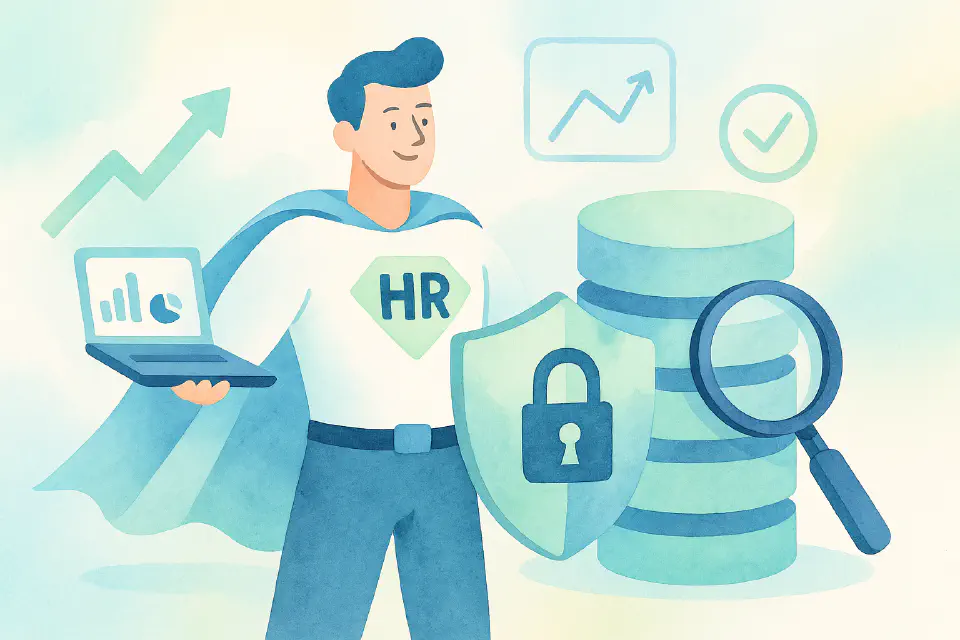
Data Governance & People Analytics Strategy
HR data is only powerful when it’s trusted, governed, and used ethically. Great analytics starts with great foundations.
In the age of AI, dashboards, and predictive insights, it’s tempting to jump straight into analytics. But without clear data ownership, defined governance, and ethical practices, HR analytics risks being untrusted, unused—or even harmful.
This article explores how to build a solid people data strategy, create accountability through data governance, and evolve from basic reporting to strategic insight that drives real business outcomes.
Why Data Matters in HR—Now More Than Ever
HR owns some of the most sensitive and strategic data in the organization:
- Headcount and cost
- Talent flows and retention
- Learning and development impact
- Performance and potential
- Engagement, sentiment, and behavior
Used well, this data becomes a lens into organizational health and a lever for strategic decisions.
The Foundation: Data Governance in HR
Before HR can become “data-driven,” it must be data-responsible.
In HR, governance must address:
- Ownership – Who owns which datasets? (e.g., HR vs. IT vs. local teams)
- Quality – Is the data accurate, consistent, and complete?
- Access – Who can see, use, and export what data—and how is this controlled?
- Ethics – Are analytics methods fair, transparent, and explainable?
- Compliance – Are data practices aligned with GDPR, EEOC, or local laws?
Key Roles in Data Governance
Effective governance involves:
- Data stewards in HR teams (quality, compliance)
- HRIS or systems leads (integration, access control)
- IT & InfoSec partners (security, architecture)
- Legal/compliance (policy and regulation)
- People analytics team (design and modeling)
People Analytics: Beyond Dashboards
People analytics is not about pretty reports—it’s about driving decisions.
Analytics maturity progresses through these stages:
- Descriptive – What happened? (reports)
- Diagnostic – Why did it happen? (correlation, segmentation)
- Predictive – What’s likely to happen? (models, risk scoring)
- Prescriptive – What should we do about it? (recommendations)
Strategic Uses of HR Data
High-impact analytics domains include:
- Workforce planning – Forecasting headcount and cost
- Talent acquisition – Pipeline conversion, source quality
- Learning impact – Course effectiveness, skill growth
- DEI analysis – Representation, equity, bias detection
- Organizational network analysis – Influence, collaboration, burnout risk
Data Ethics in People Analytics
More data ≠ more value. HR must be a guardian of ethical use, ensuring:
- Consent and transparency
- Purpose limitation (don’t overuse sensitive data)
- Avoidance of automated decision-making without human review
- Explainability of models (especially with AI)
Building the Strategy: Practical Steps
1. Audit Your Data Landscape
- What data exists?
- Where is it stored?
- Who touches it?
- How reliable is it?
2. Define Use Cases That Matter
Don’t analyze everything—focus on a few areas where better insight will drive better action.
3. Secure Leadership Support
Analytics must answer questions leaders care about. Show relevance, not sophistication.
4. Build Capability
- Upskill HR teams in data literacy
- Partner with analysts, data scientists, and business intelligence
- Use tools that democratize insight (e.g., self-service dashboards)
5. Monitor, Learn, Improve
Establish feedback loops, track usage of analytics tools, and course-correct.
Final Thought
People analytics isn’t about spying or perfection—it’s about insight that respects privacy, drives action, and builds trust. Govern your data well, and it becomes your most powerful HR asset.